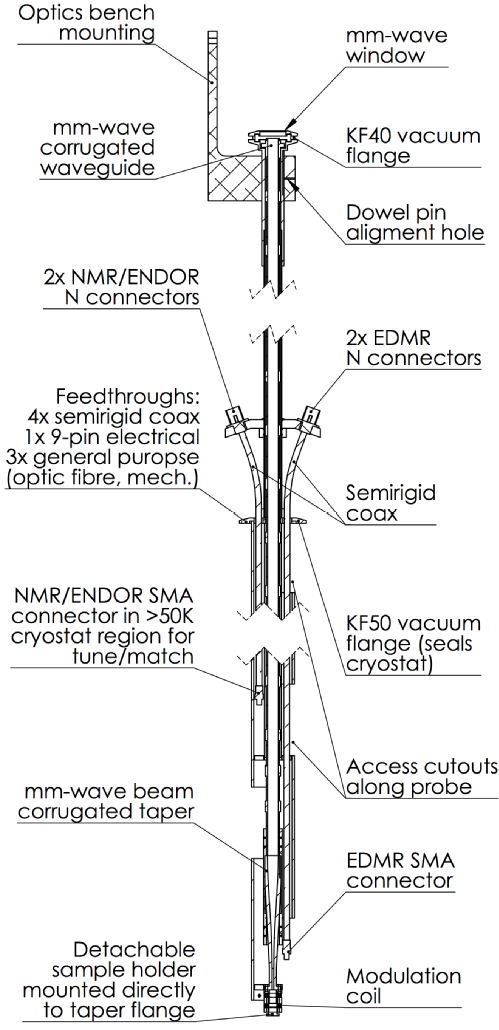Anton Tcholakov
 I am a PhD candidate at the University of Warwick under the supervision of Dr Gavin Morley
I am a PhD candidate at the University of Warwick under the supervision of Dr Gavin Morley . So far I have worked on instrumentation development for a 14.1 T magnetic resonance spectrometer capable of both electron paramagnetic resonance (EPR) and nuclear magnetic resonance (NMR). This has involved a significant amount of mechanical setup work including the development of a new probe (diagram on the left) which houses a low loss corrugated waveguide to transmit the 396.8 GHz mm-waves for EPR to our sample. I have also worked on custom instrument control software, aiming to use modern programming techniques and a high productivity programming language in order to make the software resillient and adaptable. So far, we have performed some mm-wave detected EPR experiments where we have seen a sensitivity of ~1013 spins/(mT cm3) which is comparable to other high field spectrometers [1].
. So far I have worked on instrumentation development for a 14.1 T magnetic resonance spectrometer capable of both electron paramagnetic resonance (EPR) and nuclear magnetic resonance (NMR). This has involved a significant amount of mechanical setup work including the development of a new probe (diagram on the left) which houses a low loss corrugated waveguide to transmit the 396.8 GHz mm-waves for EPR to our sample. I have also worked on custom instrument control software, aiming to use modern programming techniques and a high productivity programming language in order to make the software resillient and adaptable. So far, we have performed some mm-wave detected EPR experiments where we have seen a sensitivity of ~1013 spins/(mT cm3) which is comparable to other high field spectrometers [1].
Our spectrometer offers some unique capabilities. Firstly, thanks to our high homogeneity magnet and low-phase-noise solid state transmitter, we will be able to take advantage of the high magnetic field to achieve significant improvements in EPR spectral resolution for narrow linewidth samples such as N@C60 [2]. Secondly, we also have a fully-fledged off-the-shelf NMR console available which will offer an opportunity to explore electron-nuclear double resonance (ENDOR) DNP using hyperpolarisation agents where the hyperfine transitions can be resolved [3]. Furthermore, the high magnetic field offers the opportunity to determine the sign of the zero field splitting in certain samples where it is not possible at lower field.
In the longer term, our group is also interested in studying magnetic resonance systems for quantum information processing at high field: in particular defect centres in silicon and diamond. This will require progress in improving the phase-noise of the high frequency mm-waves at the sample. We are well-placed to make progress in this area thanks to our low phase-noise transmitter and the simplicity of our microwave bridge design.
Research interests include:
- high field EPR spectroscopy and DNP
- better programming techniques for instrument control
- microwave/mm-wave systems engineering
- quantum control and quantum information processing
[1] J van Tol, L-C Brunel and R J Wylde 2005 A quasioptical transient electron spin resonance spectrometer operating at 120 and 240 GHz Rev. Sci. Instrum. 76 074101
[2] J J L Morton, A M Tyryshkin, A Ardavan, K Porfyrakis, S A Lyon and G A D Briggs 2005 A new mechanism for electron spin echo envelope modulation J. Chem. Phys. 122 174504
[3] G W Morley, J van Tol, A Ardavan, K Porfyrakis, J Zhang and G A D Briggs 2007 Efficient dynamic nuclear polarisation at high magnetic fields Phys. Rev. Lett. 98 220501
G74 Milburn House
EPR group
Physics Department
University of Warwick
a dot p dot tcholakov at warwick dot ac dot uk
+44 24761 50813
Other interests
My appreciation for music spans many genres and I love going to live gigs. I pursue a keen interest in technology and am fascinated by the complexity of business in a field where the pace of innovation is so rapid. I have strong political opinions.